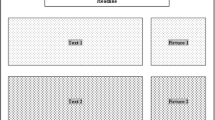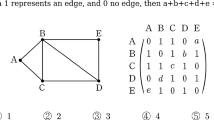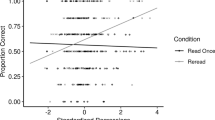Abstract
Does reading a mathematical proof for validation engender different behaviors from reading it for comprehension? Experts and novices each read two mathematical proofs under different sets of instructions: they were asked to understand one proof, and to assess the validity of the other. Their eye movements were recorded while they read and were analyzed to investigate possible differences in attention allocation, in cognitive demand and in the mathematical reading process. We found negligible differences in reading behaviors under the two sets of instructions, and we discuss the implications of this for theoretical development, research methodology and pedagogical practice.

Similar content being viewed by others
References
Ball, D. L., & Bass, H. (2000). Making believe: The collective construction of public mathematical knowledge in the elementary classroom. In D. Phillips (Ed.), Yearbook of the National Society for the study of education, constructivism in education (pp. 193–224). Chicago: University of Chicago Press.
Bax, S. (2013). The cognitive processing of candidates during reading tests: Evidence from eye-tracking. Language Testing, 30, 441–465.
Brown, S. A. (2014). On skepticism and its role in the development of proof in the classroom. Educational Studies in Mathematics, 86, 311–335.
Conradie, J., & Frith, J. (2000). Comprehension tests in mathematics. Educational Studies in Mathematics, 42, 225–235.
Cowen, C. (1991). Teaching and testing mathematics reading. American Mathematical Monthly, 98, 50–53.
Dienes, Z. (2016). How Bayes factors change scientific practice. Journal of Mathematical Psychology, 72, 78–89.
Hayward, C. N., Kogan, M., & Laursen, S. L. (2016). Facilitating instructor adoption of inquiry-based learning in college mathematics. International Journal of Research in Undergraduate Mathematics Education, 2, 59–82.
Hodds, M., Alcock, L., & Inglis, M. (2014). Self-explanation training improves proof comprehension. Journal for Research in Mathematics Education, 45, 62–101.
Inglis, M., & Alcock, L. (2012). Expert and novice approaches to reading mathematical proofs. Journal for Research in Mathematics Education, 43, 358–390.
Inglis, M., Mejía-Ramos, J.-P., Weber, K., & Alcock, L. (2013). On mathematicians’ different standards when evaluating elementary proofs. Topics in Cognitive Science, 5, 270–282.
Jacobson, J. Z., & Dodwell, P. C. (1979). Saccadic eye movements during reading. Brain and Language, 8, 303–314.
Jones, I., & Alcock, L. (2014). Peer assessment without assessment criteria. Studies in Higher Education, 39, 1774–1787.
Just, M. A., & Carpenter, P. A. (1976). Eye fixations and cognitive processes. Cognitive Psychology, 8, 441–480.
Just, M. A., & Carpenter, P. A. (1980). A theory of reading: From eye fixations to comprehension. Psychological Review, 87, 329–354. https://doi.org/10.1037/0033-295X.87.4.329.
Kasman, R. (2006). Critique that! Analytical writing assignments in advanced mathematics courses. Problems, Resources, and Issues in Mathematics Undergraduate Studies, 16, 1–15.
Knuth, E. (2002). Secondary school mathematics teachers’ conceptions of proof. Journal for Research in Mathematics Education, 33, 379–405.
Larsen, S., Johnson, E., & Bartlo, J. (2013). Designing and scaling up an innovation in abstract algebra. The Journal of Mathematical Behavior, 32, 693–711.
Larvor, B. (2016). Mathematical cultures: The London meetings 2012–2014. Basel: Birkhäuser.
Lew, K., Fukawa-Connelly, T. P., Mejía-Ramos, J. P., & Weber, K. (2016). Lectures in advanced mathematics: Why students might not understand what the mathematics professor is trying to convey. Journal for Research in Mathematics Education, 47, 162–198.
Mejía-Ramos, J. P. & Inglis, M. (2009). Argumentative and proving activities in mathematics education research. In F.-L. Lin, F.-J. Hsieh, G. Hanna & M. de Villiers (Eds.), Proceedings of the ICMI study 19 conference: Proof and proving in mathematics education (Vol. 2, pp. 88–93), Taipei, Taiwan.
Mejía-Ramos, J.-P., Fuller, E., Weber, K., Rhoads, K., & Samkoff, A. (2012). An assessment model for proof comprehension in undergraduate mathematics. Educational Studies in Mathematics, 79, 3–18.
Mejía-Ramos, J. P., Lew, K., de la Torre, J., & Weber, K. (2017). Developing and validating proof comprehension tests in undergraduate mathematics. Research in Mathematics Education, 19, 130–146.
Mello-Thoms, C., Nodine, C. F., & Kundel, H. L. (2004). What attracts the eye to the location of missed and reported breast cancers? In Proceedings of the eye tracking research and applications symposium 2002 (pp. 111–117). NY: ACM Press.
Morey, R. D., Romeijn, J.-W., & Rouder, J. N. (2016). The philosophy of Bayes factors and the quantification of statistical evidence. Journal of Mathematical Psychology, 72, 6–18.
National Council of Teachers of Mathematics. (2000). Principles and standards for school mathematics. Reston: Author.
Obersteiner, A., & Tumpek, C. (2016). Measuring fraction comparison strategies with eye-tracking. ZDM Mathematics Education, 48, 255–266.
Pomplun, M., & Sunkara, S. (2003). Pupil dilation as an indicator of cognitive workload in Human-Computer Interaction. In Proceedings of HCI International 2003 (Vol. 3, pp. 542–546). Mahwah: Lawrence Erlbaum Associates.
Rasmussen, C., Wawro, M., & Zandieh, M. (2015). Examining individual and collective level mathematical progress. Educational Studies in Mathematics, 88, 259–281.
Rav, Y. (1999). Why do we prove theorems? Philosophia Mathematica, 7, 5–41.
Rayner, K. (2009). Eye movements and attention in reading, scene perception, and visual search. Quarterly Journal of Experimental Psychology, 62, 1457–1506.
Rayner, K., & Pollatsek, A. (1981). Eye movement control during reading: Evidence for direct control. The Quarterly Journal of Experimental Psychology Section A, 33(4), 351–373.
Rouder, J. N., Morey, R. D., Verhagen, J., Swagman, A. R., & Wagenmakers, E.-J. (2017). Bayesian analysis of factorial designs. Psychological Methods, 22(2), 304–321. https://doi.org/10.1037/met0000057.
Roy, S., Alcock, L., & Inglis, M. (2017). Multimedia resources designed to support learning from written proofs: An eye-movement study. Educational Studies in Mathematics, 96, 249–266. https://doi.org/10.1007/s10649-017-9754-7.
Russo, J. E., Johnson, E. J., & Stephens, D. L. (1989). The validity of verbal protocols. Memory and Cognition, 17, 759–769. https://doi.org/10.3758/BF03202637.
Scheid, H. (2002). Elemente der Arithmetik und Algebra. Heidelberg, Berlin, Spektrum, Akad. Verl., 4. Auflage.
Selden, J., & Selden, A. (1995). Unpacking the logic of mathematical statements. Educational Studies in Mathematics, 29, 123–151.
Selden, A., & Selden, J. (2003). Validations of proofs considered as texts: Can undergraduates tell whether an argument proves a theorem? Journal for Research in Mathematics Education, 34, 4–36.
Shepherd, M. D., & van de Sande, C. C. (2014). Reading mathematics for understanding—From novice to expert. The Journal of Mathematical Behavior, 35, 74–86.
Shepherd, M. D., Selden, A., & Selden, J. (2012). University students’ reading of their first-year mathematics textbooks. Mathematical Thinking and Learning, 14, 226–256.
Sibert, J. L., Gokturk, M., & Lavine, R. A. (2000). The reading assistant: Eye gaze triggered auditory prompting for reading remediation. In Proceedings of the thirteenth annual ACM symposium on user Interface software and technology (pp. 101–107). NY: ACM Press.
Stylianides, A. J. (2007). Proof and proving in school mathematics. Journal for Research in Mathematics Education, 38, 289–321.
Stylianides, A. J., Bieda, K. N., & Morselli, F. (2016). Proof and argumentation in mathematics education research. In Á. Gutiérrez, G. C. Leder, & P. Boero (Eds.), The second handbook of research on the psychology of mathematics education: The journey continues (pp. 315–351). Rotterdam: Sense Publishers.
Thurston, W. P. (1994). On proof and progress in mathematics. Bulletin of the American Mathematical Society, 30, 161–177.
Tobii Technology. (2010). Tobii eye tracking: An introduction to eye tracking and Tobii eye trackers. Stockholm: Tobii Technology AP.
Wagenmakers, E. J., Love, J., Marsman, M., Jamil, T., Ly, A., Verhagen, J., … & Meerhoff, F. (2018). Bayesian inference for psychology. Part II: Example applications with JASP. Psychonomic Bulletin & Review, 25, 58–76.
Was, C., Sansosti, F., & Morris, B. (2017). Eye-tracking technology applications in educational research. Hershey: IGI Global.
Weber, K. (2009). Mathematics majors’ evaluation of mathematical arguments and their conception of proof. In Proceedings of the Twelfth SIGMAA on RUME Conference on Research in Undergraduate Mathematics Education, http://mathed.asu.edu/crume2009/proceedings.html.
Weber, K. (2010). Mathematics majors’ perceptions of conviction, validity and proof. Mathematical Thinking and Learning, 12, 306–336.
Weber, K., Inglis, M., & Mejía-Ramos, J. P. (2014). How mathematicians obtain conviction: Implications for mathematics instruction and research on epistemic cognition. Educational Psychologist, 49, 36–58.
Weinberg, A., Wiesner, E., Benesh, B., & Boester, T. (2012). Undergraduate students’ self-reported use of mathematics textbooks. Primus , 22, 152–175.
Yackel, E., & Cobb, P. (1996). Sociomathematical norms, argumentation, and autonomy in mathematics. Journal for Research in Mathematics Education, 27, 458–477.
Yackel, E., Rasmussen, C., & King, K. (2000). Social and sociomathematical norms in an advanced undergraduate mathematics course. The Journal of Mathematical Behavior, 19, 275–287.
Yang, K.-L., & Lin, F.-L. (2008). A model of reading comprehension of geometry proof. Educational Studies in Mathematics, 67, 59–76.
Author information
Authors and Affiliations
Corresponding author
Ethics declarations
Conflict of Interest
On behalf of all authors, the corresponding author states that there is no conflict of interest.
Additional information
Raw data and analysis scripts associated with this paper can be found at https://doi.org/10.6084/m9.figshare.5213326.v1
Appendix
Appendix
Proof P n
Theorem: For n, k ∈ ℕ, the equation (n − k) ! = nk − 1 has exactly three solutions:
(n1, k1) = (2, 1), (n2, k2) = (3, 1) and (n3, k3) = (5, 2).
Proof: Let n ∈ ℕ and assume that there exists a solution with n > 2 and n even.
Because n is even, (n − 1)! is also even.
But nk − 1 is odd for all k ∈ ℕ, so (n − k) ! ≠ nk − 1 for all even n > 2.
Now assume that there exists a solution with n > 5 and n odd.
We know that (n − 1) ∣ (n − 2)!, so it follows that (n − 1)2 ∣ (nk − 1).
By factorization of (nk − 1) we have nk − 1 = (n − 1)(1 + n + n2 + … + nk − 1).
On the one hand the second factor is divisible by (n − 1).
On the other hand by dividing this factor by (n − 1) we get the remainder k.
Thus we have shown that (n − 1) ∣ k, but this contradicts nn − 1 − 1 > (n − 1)!.
Proof P a
Theorem: ∫x−1dx = ln(x) + c.
Proof: We know that \( \int {x}^k dx=\frac{x^{k+1}}{k+1}+c \) for k ≠ − 1.
Rearranging the constant of integration gives
\( \int {x}^k dx=\frac{x^{k+1}-1}{k+1}+{c}^{\prime } \) for k ≠ − 1.
Set \( y=\frac{x^{k+1}-1}{k+1} \), and take the limit as k → − 1 as follows.
Let m = k + 1, and rearrange \( y=\frac{x^{k+1}-1}{k+1} \) to give
xm = 1 + ym or \( x={\left(1+ ym\right)}^{\frac{1}{m}} \).
Set \( n=\frac{1}{m} \). Then \( x={\left(1+ ym\right)}^{\frac{1}{m}}=\left(1+\frac{1}{m}\right)\to {e}^y \) as n → ∞ .
by properties of e.
As n → ∞, we have m → 0, so k → − 1.
In other words, x → ey as k → − 1, so y → ln(x) as k → − 1.
So \( \int {x}^k dx=\frac{x^{k+1}-1}{k+1}+{c}^{\prime }=y+{c}^{\prime}\to \ln (x)+{c}^{\prime } \) as k → − 1.
So ∫x−1dx = ln(x) + c′.
Rights and permissions
About this article
Cite this article
Panse, A., Alcock, L. & Inglis, M. Reading Proofs for Validation and Comprehension: an Expert-Novice Eye-Movement Study. Int. J. Res. Undergrad. Math. Ed. 4, 357–375 (2018). https://doi.org/10.1007/s40753-018-0077-6
Published:
Issue Date:
DOI: https://doi.org/10.1007/s40753-018-0077-6




